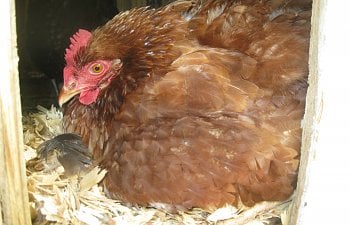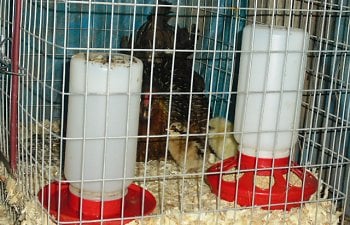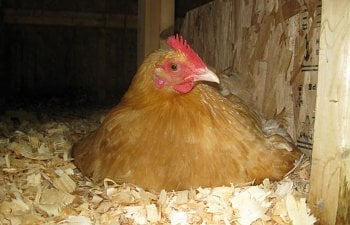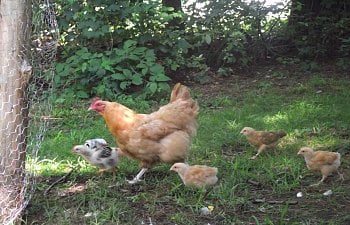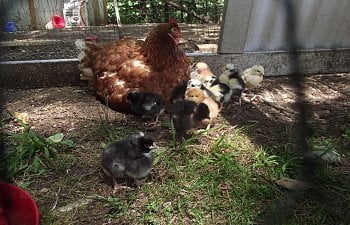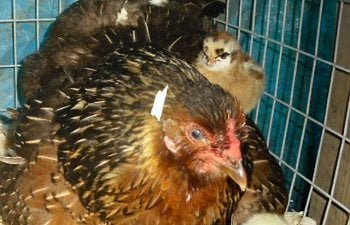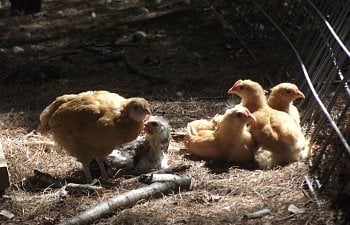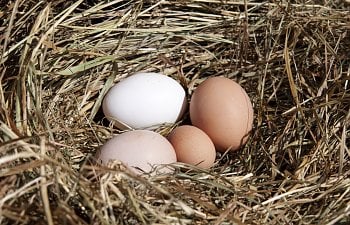Using a Broody Hen to Hatch and Raise Chicks

A broody hen is a great way to hatch chicks for you and your flock. She will do all the work, she’ll have a better hatch rate than many incubators, and, best of all, no stinky brooders to clean up. It can be nerve wrecking when you let a broody hatch for you the first time, especially if you’ve bought her really expensive hatching eggs. Hopefully this guide will help take you through it and put your mind at ease.
Getting and Identifying a Broody
The first step in using a broody hen to hatch and raise chicks is, of course, to have a broody. If you want a broody hen, not all breeds are created equal. Of the most popular breeds, silkies and cochins are some of the most broody, as well as brahmas and orpingtons. Other breeds good for brooding are the older, historic breeds among whom broodiness is the norm. Old English Games, for example, express the trait at virtually 100%, and the hens are wonderful, attentive, fiercely protective mothers. In addition to Old English Games, also consider Kraienkoppes, Malays, Shamos, Asils, Madagascar Games, and some strains of Dorking. Get one of these and you’ll have a broody. However, even supposedly non broody breeds can go broody, as you’ll see later when you meet Lemon, my red sex link.
Identifying a broody is fairly easy. They will suddenly start spending all their time on the nest, only getting up once or twice a day to eat and drink. They will also poop at this time, and it will be huge compared to regular poops, so do not be alarmed when you see this. She may also act a little more aggressive towards other birds when she’s off the nest – think about it in terms of what she’d do if she was wild. She’d want to scare other animals and birds away from her nest to protect it, so a little extra aggression is normal. She may also pluck her breast and belly to make a bare patch, which allows her to warm the eggs better. When you reach toward her while she is on the nest or try to take her eggs, she will most likely puff up at you and growl. She may even peck or bite you. If you go to collect eggs and encounter this, you probably have a broody:
Your broody hen, chances are, has gone broody in a nesting box, and probably the favorite one of all the hens. So now you must decide whether to let her brood in her box or move her to a new place. There are pros and cons of each. If you choose to let her sit in her chosen spot, it will be less stressful for her than undergoing a move. This also lets her continue to interact with the flock, and you won’t have to provide separate food and water for her. But you may get other hens laying eggs under her each day, which is problematic because after the first eggs hatch, she’s going to get up and abandon those new eggs to take care of the chicks. This is the biggest problem with this method. The easy solution is to mark her eggs and remove new ones each day. There is a chance, however, that other birds getting into her nest and jostling around can accidentally break eggs. Sometimes, a hen will be so protective of her nest that she won’t allow other birds in to lay their eggs, which solves this problem for you.
You may also decide to move her. This will keep her separate from the flock and allow her respite from other hens trying to get into her nest to lay eggs, and will also make it easier for you to keep track of her eggs. However, this will also mean more work for you. You will have to make her her own area and provide food and water for her each day. She may also refuse to sit in the new area and, if you push her enough, she may break from being broody and not hatch you any eggs at all. To decide whether or not to move her, consider your flock and its dynamics to decide if it is necessary.
To move a broody, your best bet is to wait until it is night and have her new nest all ready for her, eggs and all. If she’s already sitting on the eggs you want her to hatch, take them from her carefully, and be warned that she may peck and bite you while you do this. You may have to wear gloves. Get them settled in the new nest, and then move your hen. Hold her so that you are holding her wings against her body so she cannot flap and be prepared – she may struggle and thrash. Once you get her to the new nest area, set her down near the eggs, not on them. You don’t want her to panic and break them. She may accept the new nest, or she may refuse to sit. She may break from being broody, too. That’s the chance you take when moving her.
So now you have a broody and have her where you want her to sit. The next step is to get some eggs for her. If you have a rooster and you want to hatch some of your own eggs, chances are that’s already taken care of for you. She’s probably gone broody on some eggs already. If not, or if you want to add more than she already has, you can wait until she’s up for her daily eating and drinking and put some in her nest. If you need to take eggs from her because she has more than you want her to have, you can wait until she’s up for the day and remove them from the nest.
If you don’t have a rooster, or you want to hatch eggs other than your own, you’ll have to give them to her. When I’m purchasing expensive eggs for my broodies, I like to make sure they’re committed before giving them the eggs. I simply wait until she’s been sitting a week before I give them to her. This way I know she means business. There’s also very little chance that the extra week will make her give up too early. All my hens that I’ve given eggs to this way have always gone to hatch. I even had a silkie sit a full three months. So don’t be worried that she may not go the extra days if you choose to test her first. It’s pretty simple to give her the eggs you want her to have. While she’s waiting for the eggs, let her sit on infertile eggs or golf balls. Once you have the eggs and they’re ready to go under her, wait until she’s off the nest for the day and switch the infertile eggs or golf balls for the new eggs. That’s it. I’ve never had a broody refuse eggs. You could also slide them under her while she’s sitting, but you might get pecked and bitten this way.
This part is pretty simple. Your hen is going to do most of the work for you. The biggest things to worry about are her health and the possibility of bad eggs. Also, this is time during which you candle her eggs, if you choose. To make sure she’s staying in good health, just make sure she’s getting off the nest each day to eat and drink. I have sometimes had to physically remove a broody from her nest each to eat and drink, she was so committed. You may do this if necessary; it won’t affect the incubation as long as you’re careful not to damage any eggs while removing her. She will stay off the nest for up to half an hour, and that’s fine. It won’t hurt the eggs to cool down during this time.
Generally speaking, a broody will kick out eggs that are no good. Somehow they are able to tell. However, sometimes they don’t and that’s when you can get an egg exploding under your hen. I had this happen under a silkie once, and thankfully the rest of the eggs hatched fine, but it was a big mess and the poor hen was coated in disgusting rotten egg gunk. So to avoid this now, I candle the eggs. I usually check on day ten. If I can see veins and embryos, I know they are good and I let her keep them. If they’re clear or have a smell, they get chucked. The rest I leave up to the hen.
The Hatch
This is again something the hen will handle for you. I will check in from time to time just to make sure all is well and nothing bad is happening. I never remove an egg from under the hen during this time, and neither should you. They need to be under the hen where they have humidity and warmth to avoid hatching issues. If you leave her alone, she will very likely get them all hatched without a hitch.
I will mention that for first time broodies, you do want to check in on her during this time. Sometimes, for reasons unknown, a hen will kill newly hatched chicks or accidentally crush them to death. I even know of a hen that kicked the eggs out from under her as soon as they started to hatch. This is rare, and has never happened to me, but be aware that it may happen. Just in case, you may want to have a brooder set up to take chicks if she rejects them.
Raising the Chicks
Now that she has hatched the chicks, you have to decide whether or not you want her to raise them with the flock. Actually, you should decide this ahead of time so you have the area all set up if you do move them. I have done it both ways, and both ways have pros and cons.
Pictured above is Penny, my rescued buff orpington, with her first brood. I let her raise them with the flock. The advantages of this were that her life was less disrupted and she could continue to forage and interact with the flock as she usually would. It also allowed the chicks to get used to the rest of the flock and to have access to a varied diet with plenty of bugs and greens. The disadvantages included having to put the whole flock on chick starter, since chicks cannot eat layer pellets, and the chicks were much less protected from predators. Even crows will take very young chicks. Sometimes the rest of your flock will attack young chicks. Penny did lose two chicks.
Above is Lemon, whom I separated from the flock to raise her chicks. The advantages to this method were that I did not have to put the whole flock on chick starter; I just had to provide it for Lemon and her chicks. The chicks were also much more protected from predators and their older flock mates. Lemon has not lost any chicks. Also, Lemon proved to be a very aggressive broody and would attack any bird that she thought got too close to her chicks, resulting in several all-out brawls the rooster had to break up. The separation kept other hens safe from her. The disadvantages include having to put out food and water especially for the chicks and the hen, the chicks not getting very much interaction with other chickens, and the broody having to deal with being cooped up and unable to free range. The chicks also lose out on a lot of dietary variation. Once they were older and bigger, I did start letting Lemon and the chicks out with the flock during the day, which is the way many people do it.
If you do decide to move your hen and her chicks to a separate area, prepare the area in advance of hatch. Make it so that the flock can still see the hen and her brood so that they do not ‘forget’ her and make it hard to reintroduce her and her chicks. Wait until all the eggs are hatched, and then go ahead and move her and her babies. She will not abandon her chicks, so unlike moving a broody on eggs, there is little danger moving her.
Once you have her and the chicks situated, either with the flock or separate, the hen will do all the work of raising them. She will let them under her when they are cold, sleep on top of them to protect them at night, show them food and water, keep them safe from flock mates who might think of attacking them, and generally do all the work so all you have to do is watch them be cute. She will even let them turn her into a jungle gym.
Eventually your hen will abandon the chicks when she decides they are old enough to take care of themselves. Before this happens, she will get them integrated into the flock, and you can expect her to have them up on the roost with the other birds before she’s done with them. When she’s ready to give them up, she will start leaving them during the day. She may even peck at them if they try to follow her around. This is your cue to let her back with the flock if you had her and her chicks separate and you haven’t done so yet. Eventually she will stop sleeping with them and finally she will be back in the nesting box laying you eggs again. If you have an especially broody breed, she may lay two or three eggs and immediately begin to brood again. Either way, she is done raising her chicks and they are now old enough to live in the flock without her assistance.
More questions? Want to share your experience with a broody hen? There's a fantastic thread to do so on! You can visit The Old Fashioned Broody Hen Hatch-a-Long and Informational Thread.

